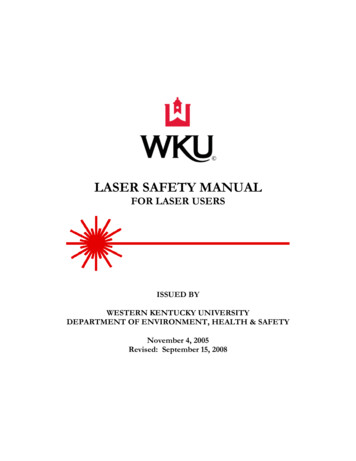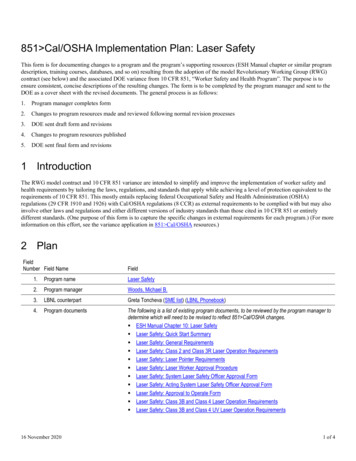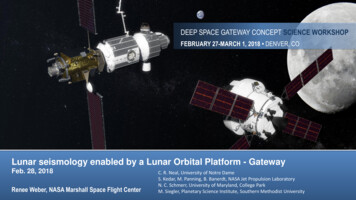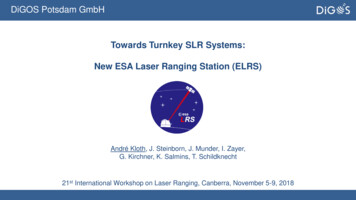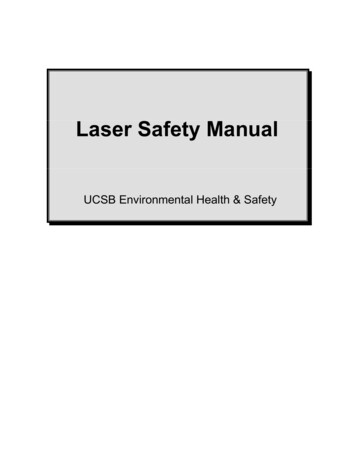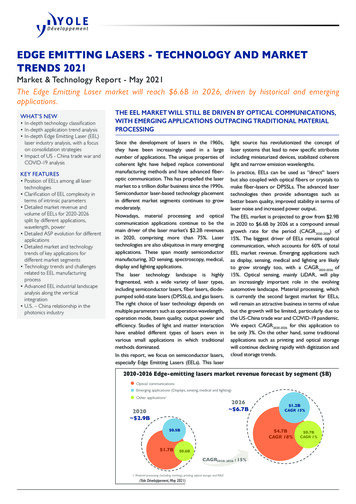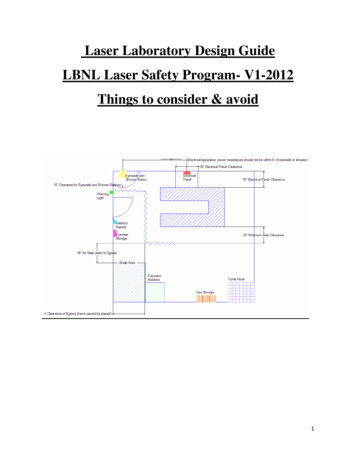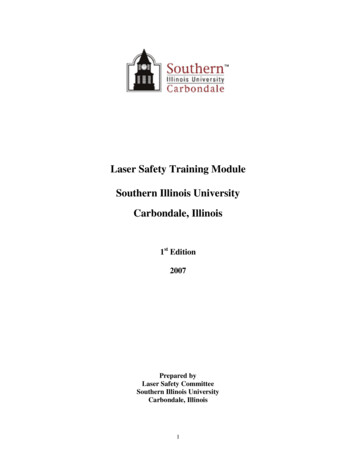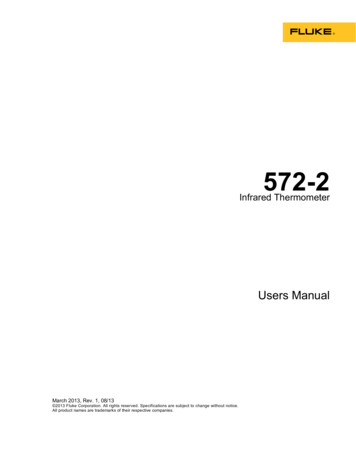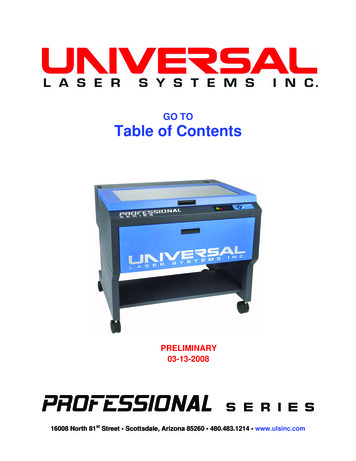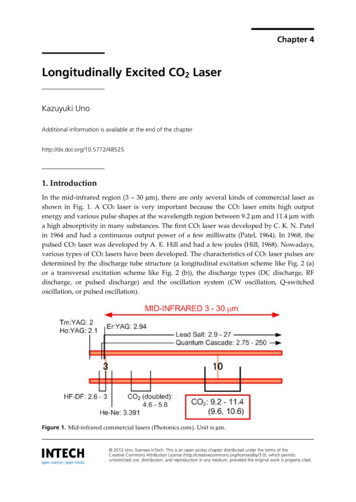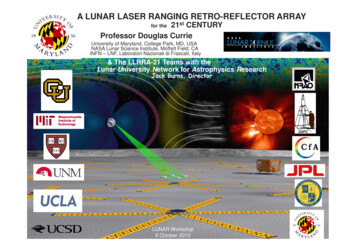
Transcription
A LUNAR LASER RANGING RETRO-REFLECTOR ARRAY21st CENTURYProfessor Douglas Curriefor theUniversity of Maryland, College Park, MD, USANASA Lunar Science Institute, Moffett Field, CAINFN – LNF, Laboratori Nazionali di Frascati, Italy& The LLRRA-21 Teams with theLunar University Network for Astrophysics ResearchJack Burns, DirectorLUNAR Workshop6 October 20101
Role of LLRRA-21 Future Goal– Much Greater Accuracy for Better Science by 200 Immediate Problem– Today, for 1 mm, only APOLLO Can Reach This– Only A Few Observations / month Immediate Goal– 1 mm Precision with a Few Returns– With a Return like Apollo 15– Multiple Stations, Similar in Capability to McDonaldLUNAR Workshop6 October 20102
Why Laser Ranging to the Moon Lunar Science - Only Way to Study Lunar Interior– Discovery of the Liquid Core– Measure the Size and Shape of Liquid Core– Many other Properties – Tidal Dissipation, Inner Core, etc. General Relativity– Negligible Effect of Non-Gravitational Forces– Many of the Best GR Tests to Date– Sufficient Mass Measurement of Inertial Properties of Grav.Energy– Variation of Fundamental Constants – Big G No Temporal Variation No Spatial VariationLUNAR Workshop6 October 20103
ASTRO2010 DECADAL SURVEYGravitational and Particle Physics PanelMuch is unknown about fundamental theory: Modifications ofgeneral relativity on accessible scales are not ruled out by today’sfundamental theories and observations. It makes sense to look forthem by testing general relativity as accurately as possible. Costeffective experiments that increase the precision of measurement ofPPN parameters, and test the strong and weak equivalenceprinciples, should be carried out. For example, improvements inLunar Laser Ranging promise to advance this area.LUNAR Workshop6 October 20104
ASTRO2010 DECADAL SURVEYGravitational and Particle Physics Panel The direct detection of gravitomagnetic effects (the Lense-Thirringprecession) from Lageos/Grace, Gravity Probe B, and lunar laser ranging.The lunar laser ranging verification of the strong equivalence principle to 104, meaning that the triple graviton vertex is now known to a better accuracythan the triple gluon vertex.Limits on the fractional rate of change of the gravitational constantG ( 10-12) Limits on the fractional rate of change of the gravitationalconstant G ( 10-12/yr) from lunar laser ranging. Atomic experimentslimiting time variation of the fine structure constant to 10-16/yr over periodsof several years.Experiments that are in progress include the Microscope equivalenceprinciple experiment, the APOLLO lunar laser ranging observations, andtests of general relativity using torsion balances and atom interferometry.Improved strong and weak equivalence principle limits. Better determinationof PPN parameters and and Ġ/G from next generation Lunar laser rangingLUNAR Workshop6 October 20105
ASTRO2010 DECADAL SURVEYGravitational and Particle Physics Panel A new Lunar Laser Ranging (LLR) program, if conducted as a low cost roboticmission or an add-on to a manned mission to the Moon, offers a promising and costeffective way to test general relativity and other theories of gravity (Figure 8.12). Sofar, LLR has provided the most accurate tests of the weak equivalence principle, thestrong equivalence principle and the constancy in time of Newton’s gravitationalconstant. These are tests of the core foundational principles of general relativity. Anydetected violation would require a major revision of current theoretical understanding.As of yet, there are no reliable predictions of violations. However, because of theirimportance, the panel favors pushing the limits on these principles when it can bedone at a reasonable cost. The installation of new LLR retroreflectors to replace the40 year old ones might provide such an opportunity. The panel emphasizes againthat its opinion that experiments improving the measurements of basic parameters ofgravitation theory are justified only if they are of moderate cost. Therefore, itrecommends that NASA’s existing program of small- and medium-scale astrophysicsmissions address this science area by considering, through peer review, experimentsto test general relativity and other theories of gravity. The panel notes that a roboticplacement of improved reflectors for LLR is likely to be consistent with theconstraints of such a program. It returns to this recommendation below in the contextof a recommendation to augment the Explorer program.LUNAR Workshop6 October 20106
ASTRO2010 DECADAL SURVEYCosmology and Fundamental Physics PanelThese complex spin-induced orbital effects are the consequences of “framedragging,” a fundamental prediction of Einstein’s theory that has been probed in theSolar System using Gravity Probe B, LAGEOS satellites, and Lunar laser ranging,and has been hinted at in observations of accretion onto neutron stars and blackholes.LUNAR Workshop6 October 20107
LLRRA-21 Teams LSSO Team – NASA Douglas Currie Principal Investigator –University of Maryland, College Park, College Park m MD, USA –NLSI, Moffett Field, CA, USA & –INFN-LNF Frascati, Italy Bradford Behr –University of Maryland, College Park, MD, USATom Murphy –University of California at San Diego, San Diego, CA , USA Simone Dell’Agnello –INFN/LNF Frascati, Italy Giovanni Delle Monache –INFN/LNF Frascati, ItalyW. David Carrier –Lunar Geotechnical Institute, Lakeland, FL, USA Roberto Vittori –Italian Air Force, ESA Astronaut Corps Ken Nordtveldt –Northwest Analysis, Bozeman, MT, USA Gia Dvali–New York University, New York, NY and CERN, Geneva, CH David Rubincam –GSFC/NASA, Greenbelt, MD, USA Arsen Hajian –University of Waterloo, ON, CanadaINFN-LNF Frascati TeamSimone Dell’Agnello PI INFN-LNF, Frascati, ItalyGiovanni Delle Monache INFN-LNF, Frascati, ItalyDouglas CurrieU. of Maryland, College Park, MD, USANLSI, Moffett Field, CA, USA &INFN-LNF, Frascati, ItalyRoberto VittoriItalian Air Force & ESA Astronaut CorpsClaudio CantoneINFN-LNF, Frascati, ItalyMarco GarattiniINFN-LNF, Frascati, ItalyAlessandro BoniINFN-LNF, Frascati, ItalyManuele MartiniINFN-LNF, Frascati, ItalyNicola IntagliettaINFN-LNF, Frascati, ItalyCaterina LopsINFN-LNF, Frascati, ItalyRiccardo MarchCNR-IAC & INFN-LNF, Rome, ItalyRoberto TaurasoU. of Rome Tor Vergata & INFN-LNFGiovanni BellettiniU. of Rome Tor Vergata & INFN-LNFMauro MaielloINFN-LNF, Frascati, ItalySimone BerardiINFN-LNF, Frascati, ItalyLuca PorcelliINFN-LNF, Frascati, ItalyGiuseppe BiancoASI Centro di Geodesia Spaziale“G. Colombo”, Matera,LUNAR Workshop6 October 20108
What have the Apollo Arrays Done The Earth-Moon System Provides an Ideal System– To Evaluate Relativity and Einstein’s Theory– To Understand the Interior of the Moon Moon is Massive enough to Resist Drag/Pressure Moon is Far Enough to be in a Solar Orbit (Weakly Bound) LLR Currently Provides our Tests of: The Weak Equivalence Principle (WEP)*: a / a 1.3 10-13The Strong Equivalence Principle (SEP): η 4β γ 1 4 10 4Time-Rate-of-Change of G to 7 10 13 per yearInverse Square Law to 3 10 11 at 10 8 m scalesGeodetic Precession to 0.6 %Gravitomagnetism to 0.1 %Initial Definition of Liquid Lunar CoreLove Numbers of the CrustFree Librations and Q of the MoonLUNAR Workshop6 October 20109
LLRRA-21 Motivations Astrophysical Science Motivations– Fundamental Incompatibility Between Quantum Mechanics and General Relativity– Dark Energy may be Aspect of Large-Scale Gravity Dvali Idea Replaces Normal GR with Leaky Gravity Can be Seen in Precession of Lunar Orbit– Dark Matter inspires Alternative Gravity Models (MOND) Further Tests of Inverse Square Law could Confirm or Deny Lunar Science Motivations– Liquid Core – Dimensions, Shape, Rotation– Inner Solid Core – Existence, Size, Rotation– Rotational Dynamics – Q, External ImpactsLUNAR Workshop6 October 201010
SHORT HISTORY Apollo Lunar Laser Ranging Arrays 1969– Thermal and Optical Analysis and Testing– McDonald LLR Station 2006– Return to the Moon– Could Address Accuracy Limit 2007– LSSO for 100 mm CCR– Lunar Science Sortie Opportunities 2009– NLSI LUNAR at University of ColoradoLUNAR Workshop6 October 201011
LIBRATION PROBLEMS Why is there a Problem with the Apollo Arrays––––––Libration in Both Axis of 8 degreesApollo Arrays are Tilted by the Lunar LibrationsCCR in Corner is Further Away by Several CentimetersEven Short Laser Pulse is SpreadResults in a Range Uncertainty by 2 cmAPOLLO Station of Tom Murphy UCSD Thousands of Returns per Normal PointRoot N to Get Range to 1 – 2 millimetersNeeds Large TelescopeHard to get Daily CoverageLUNAR Workshop6 October 201012
LUNAR Workshop6 October 201013
University of Maryland, College ParkLunar Laser Ranging Array for the 21st CenturyNominal Package
CHALLENGES for SOLID CCR Fabrication of the CCR to Required Tolerances Sufficient Return for Reasonable Operation– Ideal Case for Link Equation Thermal Distortion of Optical Performance––––Absorption of Solar Radiation within the CCRMount Conductance - Between Housing and CCR TabPocket Radiation- IR Heat Exchange with HousingSolar Breakthrough - Due to Failure of TIR Stability of Lunar Surface Emplacement––––Problem of Regolith Heating and ExpansionDrilling to Stable Layer for CCR SupportThermal Blanket to Isolate SupportHousing Design to Minimize Thermal ExpansionLUNAR Workshop6 October 201015
CCR FABRICATION CHALLENGE CCR Fabrication Using SupraSil 1 Completed Specifications / Actual––––Clear Aperture Diameter - 100 mm / 100 mmMechanical Configuration - Expansion of Our APOLLOWave Front Error - 0.25 / 0.15 [ λ/6.7 ]Offset Angles Specification– 0.00”, 0.00”, 0.00” /-0.20” Fabricated– 0.18”, 0.15”, 0.07” Flight Qualified– with CertificationLUNAR Workshop6 October 201016
THERMAL/SOLAR ANALYSISTHEORETICALSolar Absorption within CCR Solar Heat Deposition in Fused Silica––––Solar Spectrum – AMO-2Absorption Data for SupraSil 1/311Compute Decay Distance for Each WavelengthCompute Heat Deposition at Each Point Beer’s Law– Thermal Modeling Addresses: Internal Heat Transport and FluxesRadiation from CCR to SpaceRadiation Exchange with Internal Pocket SurroundingsMount Conduction into the Support TabsLUNAR Workshop6 October 201017
POCKET RADIATION EXCHANGE Challenge:– IR Radiation Between CCR & Housing– SiO2 Has High IR Absorptivity/Emissivity– Heat Flux Causes Optical Distortion Isolation Between CCR and Housing– Low Emissivity Coatings – 2% Emissivity– Successive Cans or Multiple Layers Simulation Indicates Isolation is Effective Thermal Vacuum Chamber Validation– In April 2009 at SCF at INFN/LNF at FrascatiLUNAR WorkshopOctober 2010618
INNER & OUTER THERMALSHIELDS
MOUNT CONDUCTANCE Challenge:– Heat flow from Housing to CCR at Tabs– Optical Distortion due to Heat Flux Support of CCR with KEL-F “Rings”– Intrinsic Low Conductivity– Use of Wire Inserts with Only Line Contacts Line Contact of Support Reduces Heat Flow– Supports Launch Environment KEL-F Wire Compresses and Support Comes from Ring Estimated (to be Validated in SCF) 1 Milli-W/oKLUNAR Workshop6 October 201020
Thermal AnalysisLUNAR Workshop6 October 201021
LLRRA-21 PACKAGE
CURRENT STATUS Preliminary Definition of Overall Package Completed Preliminary Simulations– LSSO – Lunar Science Surface Opportunities– Thermal (CCR, Regolith, Housing), Optical Completed Phase I Thermal Vacuum Tests– Solar Absorption Effects on CCR– CCR Time Constants – IR Camera – Front Face Thermocouples – Volume Preliminary Optical FFDPLUNAR Workshop6 October 201023
MISSION OPPORTUNITES&Acknowledgements Possible Roles for 100 mm Solid CCR Retroreflector– NASA Google Lunar X Prize - 2013 International Lunar Network (ILN) Anchor Nodes Lunar Express – Lockheed Martin Manned Landing - LSSO / NASA Program– Italian Space Agency & INFN MAGIA – ASI & INFN– Proposed ASI Lunar Orbiter to Carry a 100 mm Solid CCR Italian ILN Retroreflector Instrument– MoonLIGHT-ILN INFN Experiment – Just ApprovedLUNAR Workshop6 October 201024
Google Lunar X Prize Prize by Google Corporation for 30 M – Only Private Funds to Accomplish GLXP Objectives Government Money is Acceptable for Non-GLXP Goals– For Other Objectives – Like LLRRA-21 Currently I am Working with:––––––Lunar Express, LMAstroboticsMoon ExpressNextGreatLeapPenn State UniversityFREDNETHai LiDavid GumpBob RichardsMichael JoyceMiles SmithSean Casey Multiple Missions that May Be Successful– Achieve an Array of Retroreflectors
Thank You!Any Questions?LUNAR Workshop6 October 201026
Paper on LLR for Decadal Survey– witz.pdf Sept 2007 - Google Lunar X- Prize http://commercialspace.pbworks.com/f/Public Background.pdf http://commercialspace.pbworks.com/f/Public ILN.pdf
full moonAPOLLO rates on Apollo 15 reflectorbackground level28
What’s Wrong? – thermal nature– absorbing solar fluxcool, quick routewarm, slow roadThe full-moon deficit, togetherwith normal eclipse behavior,gives us the best clues: Most likely: dust– Obviously could explain overalldeficit (10%) Full moon effect then due tosolar heating of dust– sun comes straight down tubeat full moon– makes front hotter than vertexof corner cube, leading todivergence of exit beam– only takes 4 C (7 F) gradient tointroduce 10 reduction29
Illumination; Thermal GradientGradient; Return StrengthCartoon of Expectationshot faceresponse peakzero crossingcold faceTime30
Preliminary Eclipse Resultsfull shadowApollo 11Apollo 14(Apollo 15)/3.0historical peak range @ F.M.robust recovery initially, then down, and brief resurgence once light returns31
precession) from Lageos/Grace, Gravity Probe B, and lunar laser ranging. The lunar laser ranging verification of the strong equivalence principle to 10-4, meaning that the triple graviton vertex is now known to a better accuracy than the triple gluon vertex. Limits on the fractional rate of change of the gravitational constant
